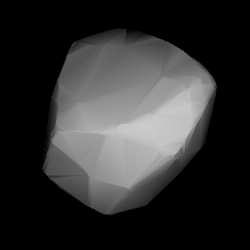1457 Ankara

 Shape of Ankara modelled from its lightcurve | |
| Discovery[1] | |
|---|---|
| Discovered by | K. Reinmuth |
| Discovery site | Heidelberg Obs. |
| Discovery date | 3 August 1937 |
| Designations | |
| (1457) Ankara | |
Named after | Ankara (Turkish capital)[2] |
| 1937 PA · 1933 SA 1934 XG · 1936 FL1 1943 YD · 1966 BG | |
| main-belt · (middle)[3] | |
| Orbital characteristics[1] | |
| Epoch 16 February 2017 (JD 2457800.5) | |
| Uncertainty parameter 0 | |
| Observation arc | 82.95 yr (30,296 days) |
| Aphelion | 3.1134 AU |
| Perihelion | 2.2802 AU |
| 2.6968 AU | |
| Eccentricity | 0.1545 |
| 4.43 yr (1,618 days) | |
| 63.234° | |
| 0° 13m 21.36s / day | |
| Inclination | 6.0913° |
| 296.31° | |
| 296.31° | |
| Physical characteristics | |
| Dimensions | 17.834±0.207 km[4] 18.495±0.068 km[5] 18.95±0.63 km[6] 19.82±0.26 km[7] 29.08 km (calculated)[3] |
| 31.8±0.6 h[8] | |
| 0.1 (assumed)[3] 0.258±0.051[6] 0.262±0.008[7] 0.3038±0.0536[5] 0.320±0.037[4] | |
| S[3] | |
| 10.60[7][5] · 10.70[6] · 10.8[1][3] | |
1457 Ankara, provisional designation 1937 PA, is a stony asteroid from the central region of the asteroid belt, approximately 18 kilometers in diameter. It was discovered on 3 August 1937, by German astronomer Karl Reinmuth at Heidelberg Observatory in southwest Germany, and later named for the Turkish capital city of Ankara.[2][9]
Orbit and classification[edit]
Ankara orbits the Sun in the middle of the main-belt at a distance of 2.3–3.1 AU once every 4 years and 5 months (1,618 days). Its orbit has an eccentricity of 0.15 and an inclination of 6° with respect to the ecliptic.[1] It was first observed as 1933 SA at Uccle Observatory in 1933, extending the body's observation arc by 4 years prior to its official discovery observation at Heidelberg.[9]
Physical characteristics[edit]
Rotation period[edit]
A rotational lightcurve of Ankara was obtained from photometric observations by French amateur astronomer René Roy in September 2004. Lightcurve analysis gave a rotation period of 31.8 hours with a brightness variation of 0.21 magnitude (U=2).[8] While not being a slow rotator, Ankara's spin rate is slower than that of most asteroids, which typically rotate within 20 hours once around their axis.
Diameter and albedo[edit]
According to the surveys carried out by the Japanese Akari satellite, and NASA's Wide-field Infrared Survey Explorer with its subsequent NEOWISE mission, Ankara measures between 17.834 and 19.82 kilometers in diameter and its surface has an albedo between 0.258 and 0.320.[4][5][6][7]
The Collaborative Asteroid Lightcurve Link (CALL) assumes a lower albedo of 0.10 – a compromise value that lies between the albedos for stony (0.20) and carbonaceous (0.057) asteroids, chosen by CALL for all non-family asteroids with a semi-major axis between 2.6 and 2.7 AU – and consequently calculates a larger diameter of 29.08 kilometers with an absolute magnitude of 10.8, as a body's diameter and albedo are inversely related to each other.[3]
Naming[edit]
This minor planet was named after the Turkish capital Ankara. The official naming citation was proposed by Wolfgang Gleißberg, a German Solar astronomer, who immigrated to Turkey, after he was dismissed at the Breslau Observatory in Nazi Germany in 1933, because he had a Jewish grandfather. The citation was first mentioned in The Names of the Minor Planets by Paul Herget in 1955 (H 131).[2][10]
References[edit]
- ^ a b c d "JPL Small-Body Database Browser: 1457 Ankara (1937 PA)" (2016-08-27 last obs.). Jet Propulsion Laboratory. Retrieved 27 April 2017.
- ^ a b c Schmadel, Lutz D. (2007). "(1457) Ankara". Dictionary of Minor Planet Names – (1457) Ankara. Springer Berlin Heidelberg. p. 117. doi:10.1007/978-3-540-29925-7_1458. ISBN 978-3-540-00238-3.
- ^ a b c d e f "LCDB Data for (1457) Ankara". Asteroid Lightcurve Database (LCDB). Retrieved 27 April 2017.
- ^ a b c Masiero, Joseph R.; Grav, T.; Mainzer, A. K.; Nugent, C. R.; Bauer, J. M.; Stevenson, R.; et al. (August 2014). "Main-belt Asteroids with WISE/NEOWISE: Near-infrared Albedos". The Astrophysical Journal. 791 (2): 11. arXiv:1406.6645. Bibcode:2014ApJ...791..121M. doi:10.1088/0004-637X/791/2/121. Retrieved 27 April 2017.
- ^ a b c d Mainzer, A.; Grav, T.; Masiero, J.; Hand, E.; Bauer, J.; Tholen, D.; et al. (November 2011). "NEOWISE Studies of Spectrophotometrically Classified Asteroids: Preliminary Results". The Astrophysical Journal. 741 (2): 25. arXiv:1109.6407. Bibcode:2011ApJ...741...90M. doi:10.1088/0004-637X/741/2/90.
- ^ a b c d Masiero, Joseph R.; Mainzer, A. K.; Grav, T.; Bauer, J. M.; Cutri, R. M.; Nugent, C.; et al. (November 2012). "Preliminary Analysis of WISE/NEOWISE 3-Band Cryogenic and Post-cryogenic Observations of Main Belt Asteroids". The Astrophysical Journal Letters. 759 (1): 5. arXiv:1209.5794. Bibcode:2012ApJ...759L...8M. doi:10.1088/2041-8205/759/1/L8. Retrieved 27 April 2017.
- ^ a b c d Usui, Fumihiko; Kuroda, Daisuke; Müller, Thomas G.; Hasegawa, Sunao; Ishiguro, Masateru; Ootsubo, Takafumi; et al. (October 2011). "Asteroid Catalog Using Akari: AKARI/IRC Mid-Infrared Asteroid Survey". Publications of the Astronomical Society of Japan. 63 (5): 1117–1138. Bibcode:2011PASJ...63.1117U. doi:10.1093/pasj/63.5.1117. (online, AcuA catalog p. 153)
- ^ a b Behrend, Raoul. "Asteroids and comets rotation curves – (1457) Ankara". Geneva Observatory. Retrieved 27 April 2017.
- ^ a b "1457 Ankara (1937 PA)". Minor Planet Center. Retrieved 27 April 2017.
- ^ Angelika Rieber. "Wolfgang Gleissberg – Refuge in Turkey". Project Jewish Life in Frankfurt. Archived from the original on 4 January 2017. Retrieved 27 April 2017.
External links[edit]
- Asteroid Lightcurve Database (LCDB), query form (info Archived 16 December 2017 at the Wayback Machine)
- Dictionary of Minor Planet Names, Google books
- Asteroids and comets rotation curves, CdR – Observatoire de Genève, Raoul Behrend
- Discovery Circumstances: Numbered Minor Planets (1)-(5000) – Minor Planet Center
- 1457 Ankara at AstDyS-2, Asteroids—Dynamic Site
- 1457 Ankara at the JPL Small-Body Database